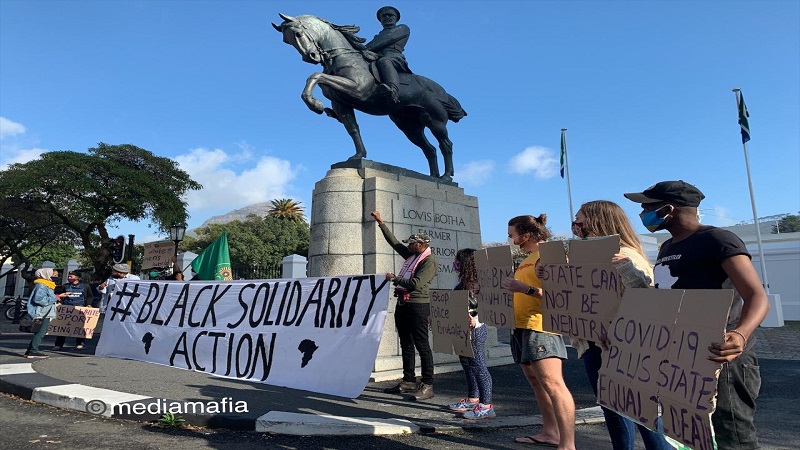As South Africa celebrates Heritage Month, questions have been raised over the relevance of pre-democratic era symbols throughout the country. It comes as Parliament’s Department of Sport, Arts and Culture has been instructed to conduct an audit on all statues and monuments, to ensure they reflect the current heritage landscape “and how Cabinet responds to the historical and critical values of the Constitution”. Cabinet has proposed that the removed structures be placed in theme-parks. The Democratic Alliance has objected to the proposal, saying far from contributing to nation-building, this move will “contribute to the polarisation of our society”.
Wandile Kasibe, a PHD candidate in sociology at the University of Cape Town and co-founder of #RhodesMustFall movement, argued that some of the structures are revered for crimes against the nation’s indigenous people and should not be preserved.
The debate around the removal of colonial monuments was reignited in South Africa after the statue of British imperialist Cecil Rhodes was removed on April 9th in 2015, following the inception of the movement.
Speaking to VOC’s Breakfast Beat on Tuesday, Kasibe explained that the removal was crucial considering Rhode’s acts of genocide, “other colonial crimes” and his role in creating “laws that made it difficult for black people to live as dignified human beings.”
“Rhodes usurped the whole country and made it his own private property, extracted natural resources of our people and immersed wealth at the expense of our forefathers. (We had) such a symbol solidified at the heart of the university and, as black people, we couldn’t stand on the side lines of history and be traumatized and suffocated,” said Kasibe.
He noted the movement’s ripple effect across the country, which gave rise to similar groups calling for action. Kasibe believes it’s time to question the relevance of other colonial structures, adding that society has to adapt.
“For us, as the movement, this decision to remove colonial symbols is long overdue. That should have happened immediately after the wave of 2015,” he said.
However, the DA believes the government is trying to sanitise public spaces by reflecting “a government-approved history that pays tribute to government-approved heroes”.
“Removing statues, symbols and monuments that do not form part of this narrative to “theme parks” allows the ANC government to control how these statues are presented in the historical narrative to future generations. It silences the voices of the people for whom these statues, and the stories they tell, hold meaning, and denies them space in the new South Africa,” said the party in a statement.
“The DA regards the moving of statues and monuments in a very serious light. It creates serious questions around the ANC government’s intention of nation-building.”
LISTEN:
Kasibe accused those trying to protect the structures of being “those who still think of black people as sub-human”.
“These symbols are a glorification of white supremacy and therefore add no value to a post-apartheid South Africa. They only appease the sensibilities of those racist whites who want to preserve and hold on to the idea of their perceived white supremacy,” he said.
“These people are stuck in that Apartheid mentality. They hold all of us at ransom. They think their white pigmentation gives them the right to undermine the dignity of black people.”
He compared other statues such as Louis Botha, Queen Victoria, and Jan Van Riebeek to a proverbial “knee on the neck” of South Africans. He was referencing what has become a symbol of the oppression and pain of black people worldwide, highlighted in the recent #BlackLivesMatter demonstrations across the globe which were sparked by a white police officer’s murder of a black man. The mass movement has brought into sharp focus the normalisation of white supremacy and police brutality against people of colour.
When questioned about the effect that the removal of colonial relics will have on history, Kasibe stated that the current structures are not an accurate depiction of the struggle.
He dubbed it as “historical justice for a process which destroyed African people.”
“There are people who claim that (the removal) is an erasure of history. They tend to forget that even the erection of these colonial symbols was actually an erasure of other people’s history. It was the outcome of the destruction of native and indigenous people. We were here before the Western forces,” he said.
“You can’t claim that we are tampering with somebody’s history when you yourself actually tampered with someone else’s history. We cannot run away from the fact that when the likes of Jan Van Riebeek arrived here and started taking over and stealing our land through the barrel of a gun… That was not a cosy and friendly process. Our people were killed.”
Kasibe also accused the government of moving at a slow space and encouraged society to increase pressure.
Heritage Month is being commemorated under the theme ‘Celebrating South Africa’s Living Human Treasures’ this year.
VOC






 WhatsApp us
WhatsApp us 

